|
In the day-ahead market on JEPX (Japan Electric Power Exchange), the 24-hour spot power prices on a weekly average basis for Mar 18-22 delivery rebounded from the previous week in both East Japan and West Japan. The temperatures stayed below the previous week's levels, trimming volumes of offers cast into the spot auction. Bids outstripped offers mostly during the week, a factor that drove spot prices higher. For post-holiday delivery on Mar 21, spot prices hit the intraday high of Yen 36.59 during 18:30-19:00 hours in all of nine areas. In evening and night time hours, or the time zone insensitive to photovoltaic generation, spot prices were glued to double digits in the Yen 30 and Yen 20 levels. It was the first time to see any price above Yen 30 since Sep 21. The spike reminded market players that spot prices could unexpectedly jump sky high in case of unseasonable weather conditions and trouble-led shutdowns of thermal units, at a time when an increasing number of thermal units are entering regular maintenance.
In Tokyo and Kansai, the key areas in East Japan and West Japan, the 24-hour average posted a difference in favor of the East by Yen 2.01 for Mar 18 delivery, Yen 0.03 for Mar 19 delivery, Yen 0.62 for Mar 20 delivery, Yen 0.01 for Mar 21 delivery and Yen 0.93 for Mar 22 delivery.
In the fuel markets, LNG prices gained ground from the previous week. Coal prices softened, but crude oil prices rose moderately.
DES Northeast Asia spot LNG prices hovered in the high $9 level per mmBtu for prompt April 2024 arrival as of Mar 21, up more than 50cts from the end of the previous week (Mar 15). LNG prices tentatively exceeded the $10 mark. The market was bolstered by a strength in European natural gas prices, at a time when a tropical cyclone in Australia disrupted ocean transportation. The Ministry of Economy, Trade and Industry (METI) announced on Mar 21 that Japan's LNG inventories for power generation stood at 1.60 mil mt as of Mar 17, down 110,000mt from the previous week. The level was way below 2.33 mil mt as of end-March last year and the average of past five years at 2.14 mil mt.
FOB Newcastle thermal coal prices in Australia hovered in the high $124level per ton for April 2024 loading as of the latter half of the week. The level was down nearly $5 from the end of the previous week. The coal market was outpaced by sell-offs as recent hikes boosted high price concerns.
In the crude oil market, WTI crude for May 2024 stood in the high $80 level as of morning on Mar 22 while Brent crude for May 2024 was trading in the mid $85 level. Both WTI and Brent rose moderately by about 30cts from the end of the previous week. Crude prices found support from a drawdown in US crude oil inventories. In addition, the International Energy Agency (EIA) forecast oil supply-demand fundamentals in 2024 would tighten up. Bullish and bearish factors played a tug of war, leaving the market deadlocked. Oil supply from Russia was expected to shrink, but the crude market was overshadowed by concerns over a deteriorating economy in Europe. Besides that, a stronger dollar made crude futures unattractive.
The actual highest price during the week was at Yen 36.59 in all of nine areas and the system price (SP) for Mar 21 delivery. Meanwhile, the actual lowest price during the week was at Yen 0.01 in five areas from Hokuriku to Kyushu and for Mar 18 delivery and SP, and Kyushu for Mar 20-22.
By area, the weekly average of the 24-hour spot prices was at Yen 13.74 in Hokkaido, up Yen 1.92 from the previous week, Yen 12.25 in Tohoku, up Yen 1.74, Yen 12.25 in Tokyo, up Yen 1.17 Yen 1.09, Yen 11.93 in Chubu, up Yen 1.64, Yen 11.59 in Hokuriku, up Yen 1.50, Yen 11.53 in Kansai, up Yen 1.80, Yen 11.53 in Chugoku and Shikoku, up Yen 1.83, and Yen 9.94 in Kyushu, up Yen 1.01.
In the JEPX auction, volumes of offers were 972.77 mil kWh on a weekly average basis, down 5.7% from the previous week. Meanwhile, bids on a weekly average basis increased by 4.4% to 948.32 mil kWh. The weekly average of trade volumes grew by 1.9% to 682.83 mil kWh.
Power demand in nine areas of Japan during Mar 18-22 was a combined 12,658.24 mil kWh, down 0.1% from 12,666.75 mil kWh Mar 11-15. The figure was up 17.6% from the corresponding period a year earlier. Demand during Mar 20-24, 2023 after day of week adjustment was 10,760.51 mil kWh.
In the JEPX forward market, no deals were confirmed during Mar 18-22.
Deals reported on TOCOM (Tokyo Commodity Exchange) during Mar 18-22 were as below.
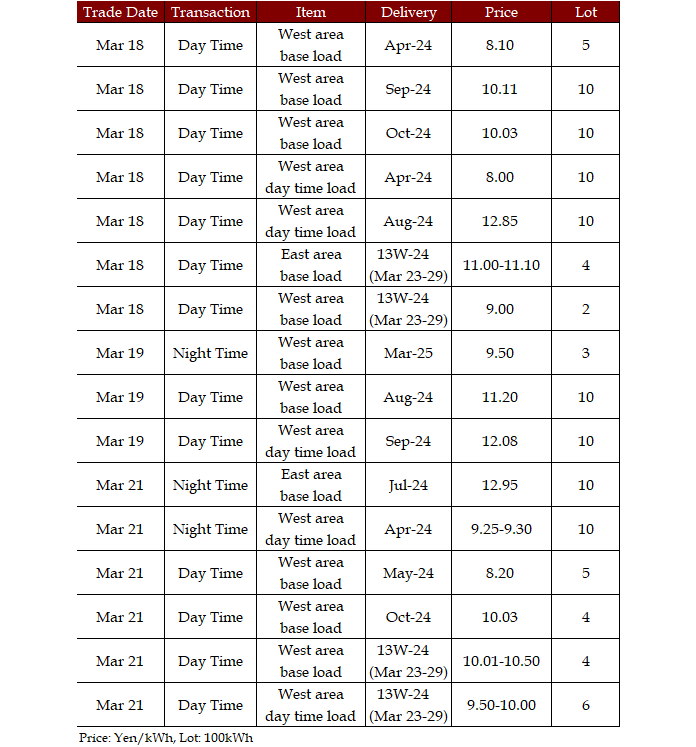
Deals reported on EEX (European Energy Exchange) during Mar 18-22 were as below.
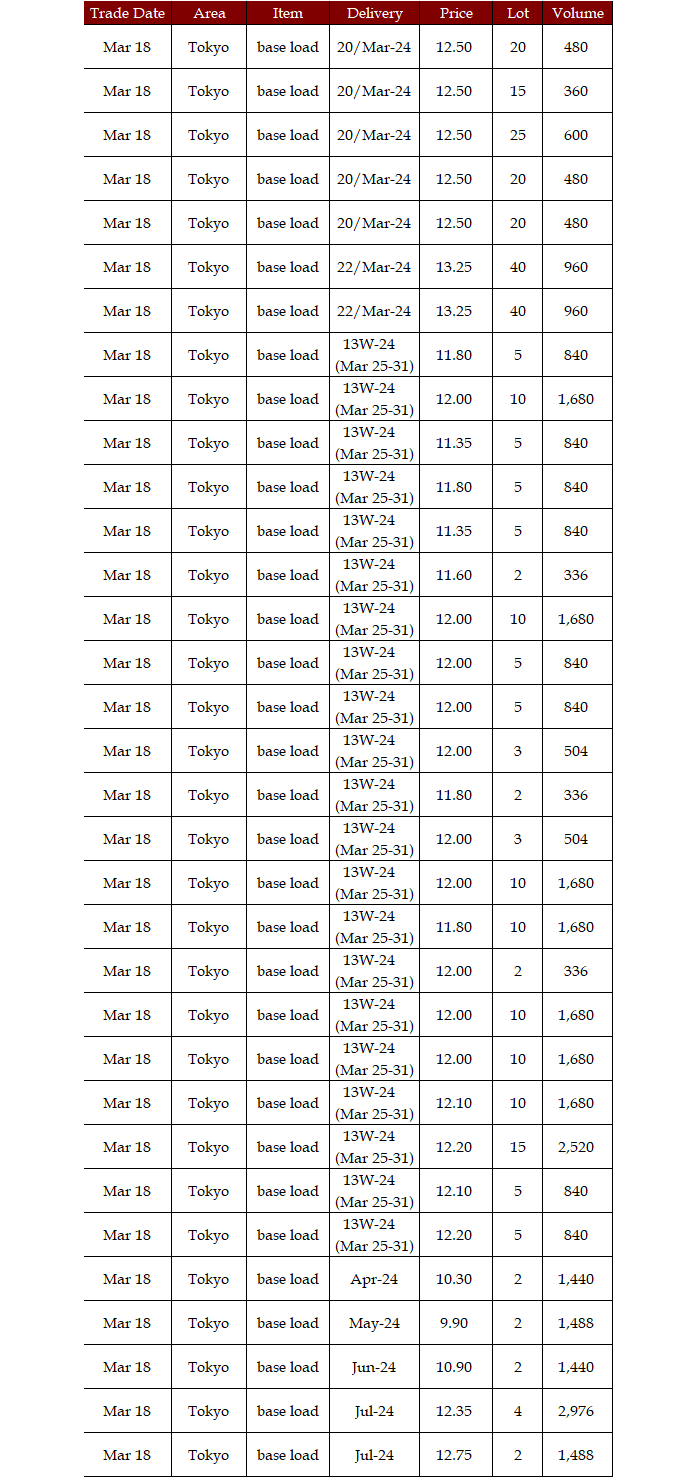
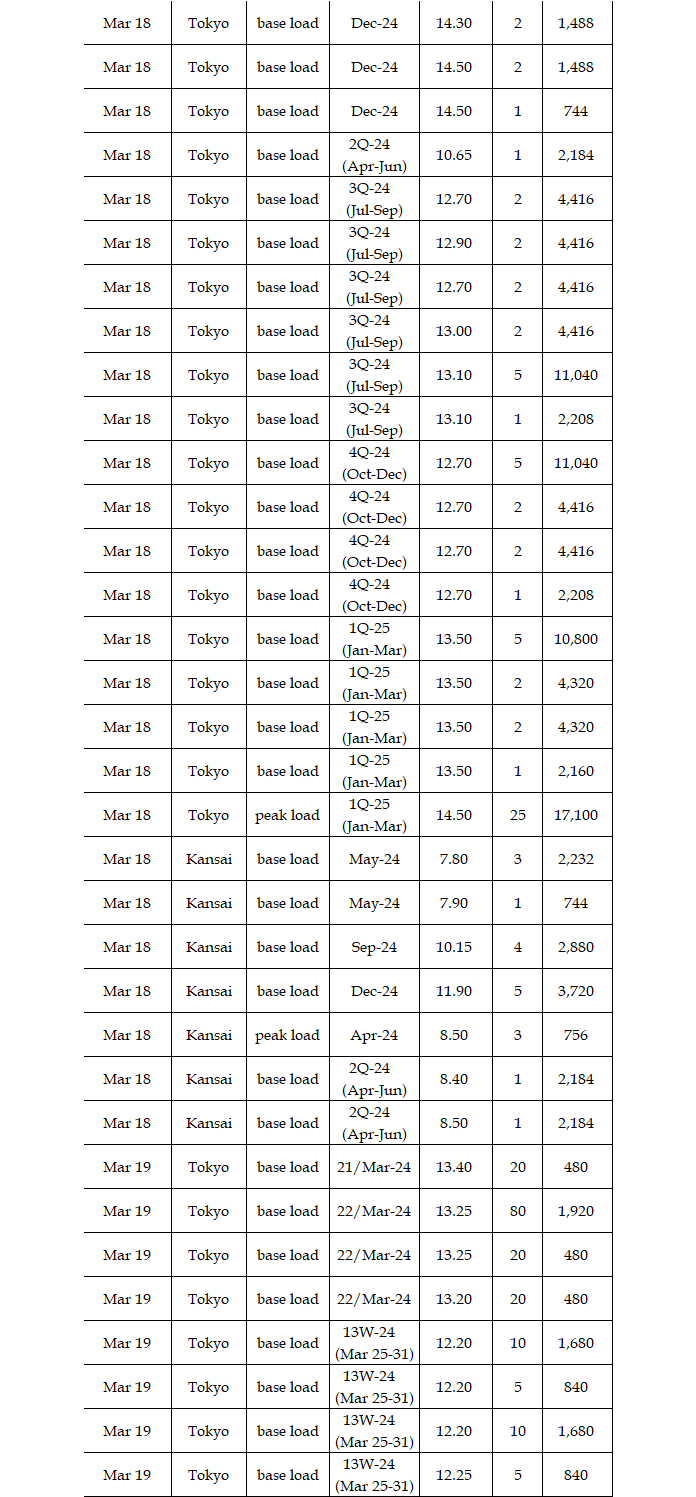
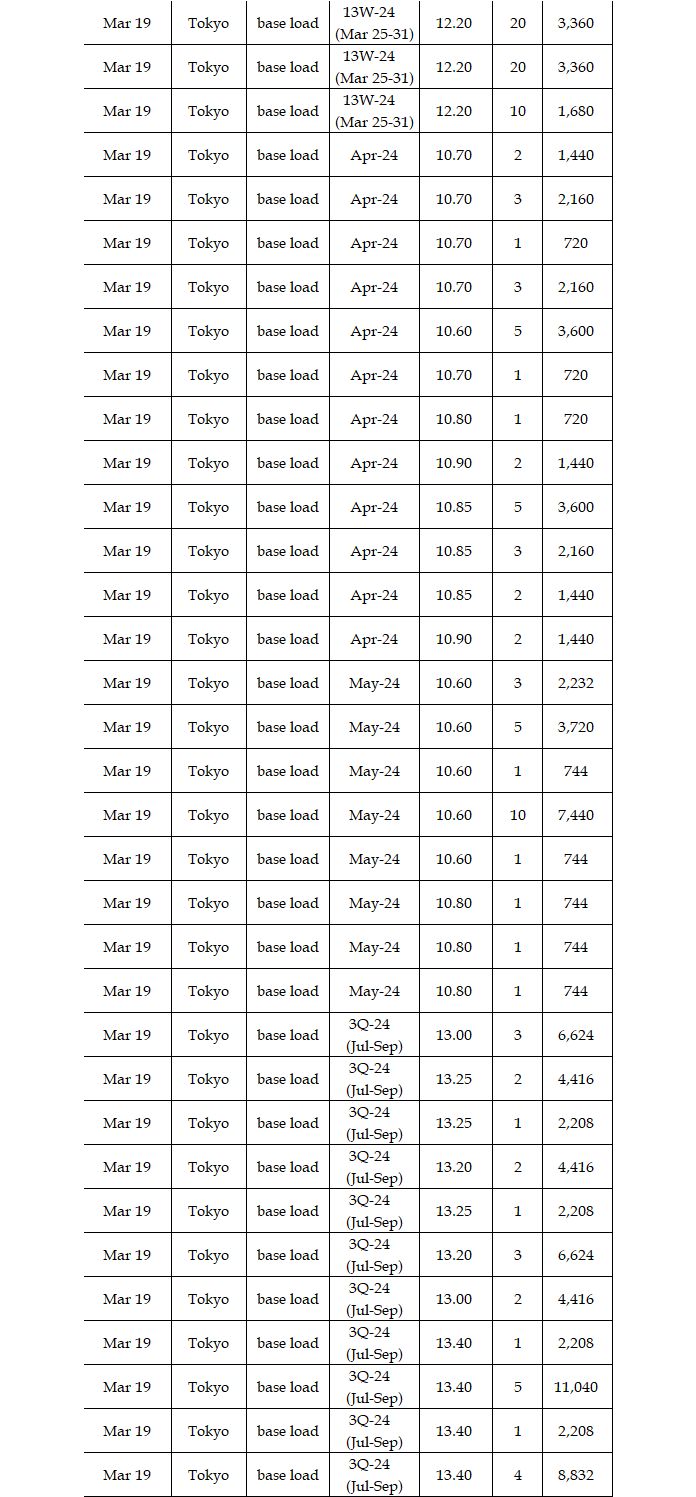
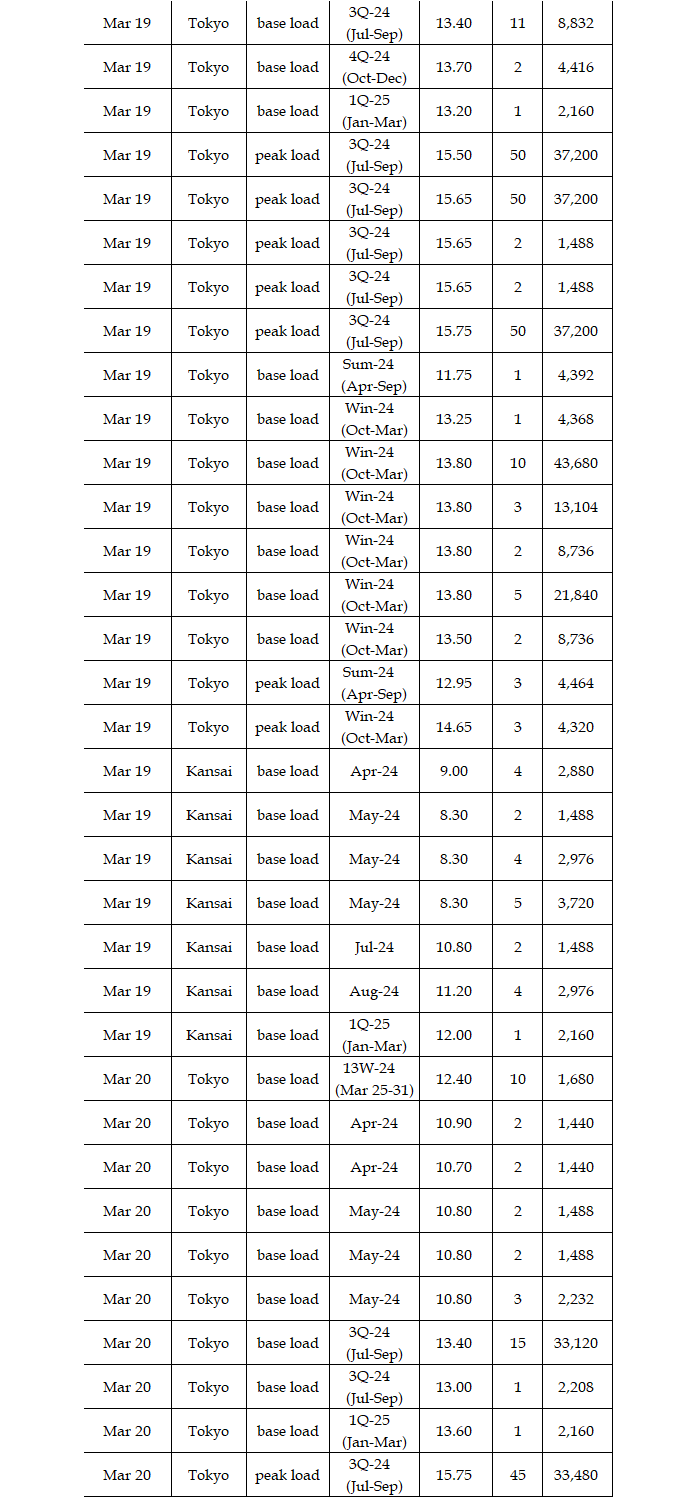
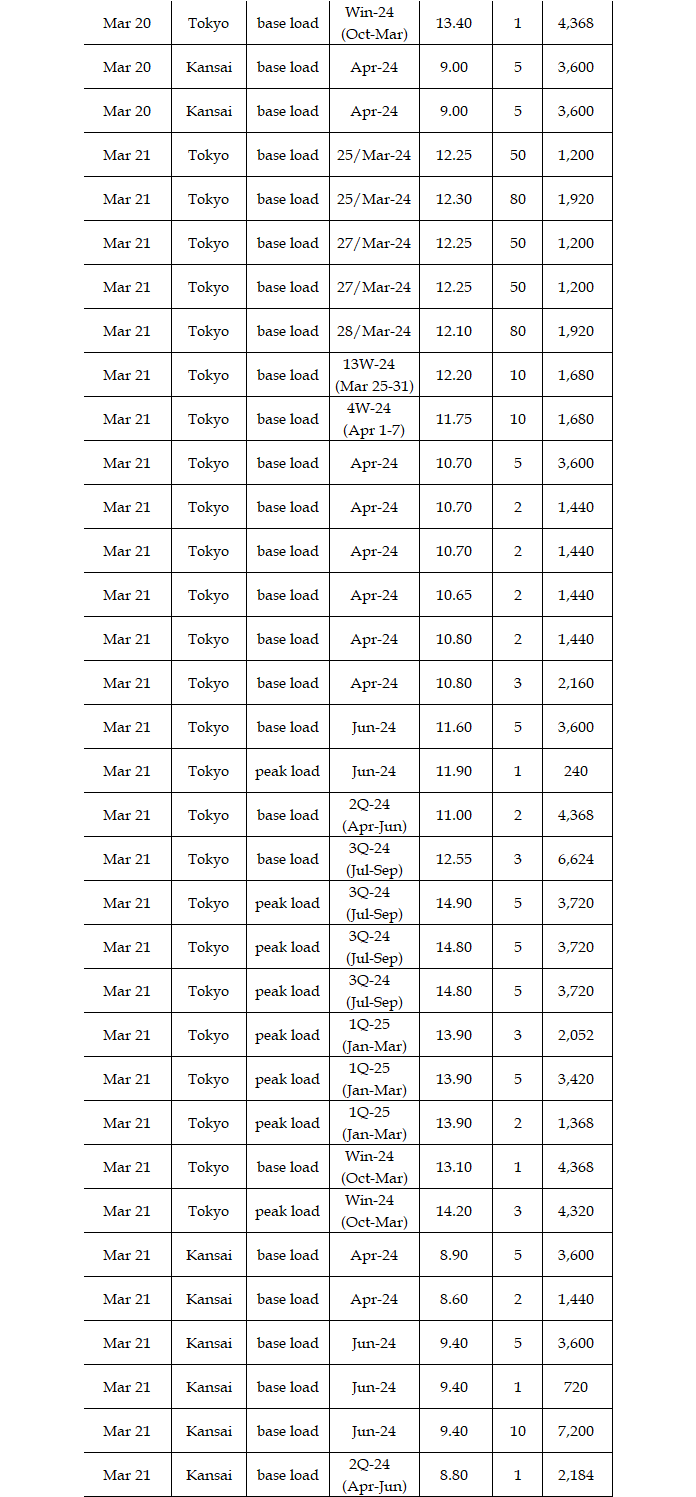
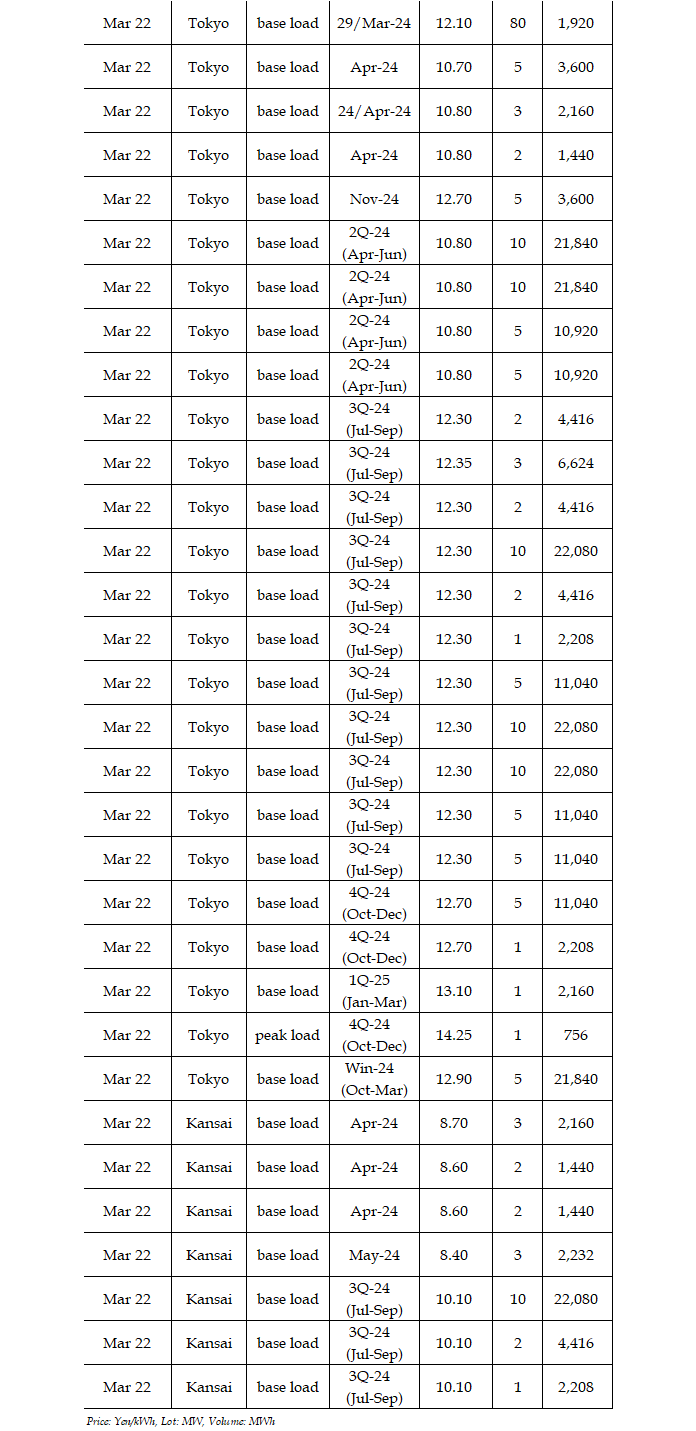
In the final week of March, spot power prices are expected to soften from the fourth week. The temperatures are forecast to rise sharply from the fourth week, and a slowdown in buying interest is likely to put a lid on spot prices. But the weather will be partly rainy mostly during the week, so that a tightness in solar power supply is believed to help spot prices resist downside pressure during midday (08:00-16:00 hours).
|
JEPX: System Price (Day Ahead 24 hours)
|
|
Weekday Price
|
18-Mar
|
19-Mar
|
20-Mar
|
21-Mar
|
22-Mar
|
|
24-Hour Ave
|
9.78
|
11.94
|
11.75
|
14.36
|
11.85
|
|
Volume (MWh)
|
700,113
|
687,220
|
666,662
|
646,092
|
714,064
|
|
(unit: yen per kWh) (date: delivery day)
|
|
|

|